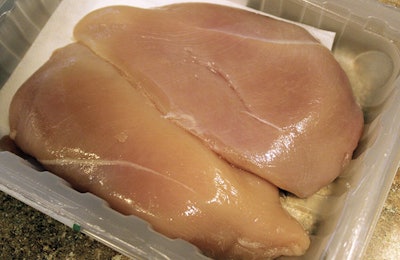
Researchers at the University of California, Davis examined the role of macrophages and vascular inflammation in the development of white striping disease during the growth process of broilers.
White striping, one of the most common muscle tissue defects in broilers, makes white striations appear in the breast meat. Breast meat from birds with the disease is still nutritious, however consumers do not typically like how it tastes.
“Changes in quality can affect consumer acceptance,” explained Michael Mienaltowski, DVM, Associate Professor in the Department of Animal Science at the University of California, Davis. “Ultimately, I think that the industry would appreciate being able to cost-effectively grow broilers that generate high quality meat. White striping is an impediment to that goal.”
How the study was conducted
The project followed broilers fed a commercial diet from hatching to market weight. Each week, the researchers performed gross pathology and histopathology analysis on samples that were collected from culled birds.
“Finally, from some of the muscle tissue collected from each broiler, we isolated RNA and performed next generation sequencing on the mRNA (messenger RNA),” Mienaltowski said. “In examining the thousands of genes of the genome, we found patterns showing microvascular damage and white blood cell infiltration into the tissue.
The research revealed that the severity of gross and histologic pathologies in the breast muscle increased as the birds aged, with white striping initially observed at week two. By weeks five and six, the myopathy had progressed to severe levels.
“From our findings, we believe that it would be worthwhile for interventions to prevent or reduce striping be utilized somewhere in weeks 2-4 after hatching,” he added. "Interventions could be as simple as changes to diet formulations or changes in broiler genetics.”
The study will be published in the April 2021 issue of Poultry Science and was funded by the U.S. Poultry and Egg Association (USPOULTRY).
“The poultry industry wants to create good yields of high-quality meat with each broiler it grows. Of course, with rapid growth and improved yield sometimes come compromises in meat quality. I don’t think growth/yield and quality ever have to be mutually exclusive though,” Mienaltowski said.
“Hopefully with our research, along with the research of many great animal scientists and nutritionists across the country and the world, we will come up with more recommendations to ultimately change that dynamic so that we are able to produce more (high yield) and better (even better quality) meat.”
Like what you just read? Sign up now for free to receive the Poultry Future Newsletter.


















